|
HOME > What is Noto's Satoyama and Satoumi? > Designation of Noto's Satoyama and Satoumi as GIAHS 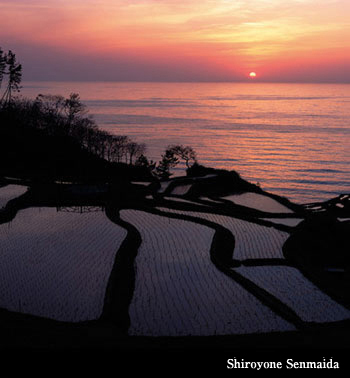

Traditional agricultural, forestry and fishing methods and land use which protect biodiversity Traditional agricultural method such as "hazaboshi", rice sheaves drying on wooden stilts, and traditional fishing such as "ama" women skin divers are still being practiced. The area is spread out like a mosaic of rice terraces along mountain slopes, paddy fields in the valley below and over 2,000 irrigation ponds that supply water for agriculture. The ecosystem is sustainable, and it provides habitat and breeding ground for organisms including endangered species. Diverse biological resources in Satoyama and Satoumi Many organisms, including rare species such as the diving beetle (dytiscus sharpi), the Hokuriku salamander, and the tiger beetle (cicindela anchoralis) live and breed in Noto's Satoyama and Satoumi, and over 300 kinds of migratory birds have been identified in the area. In addition, cultivation of native species Noto vegetables like "nakajimana" (a green leafy vegetable) and Noto "dainagon" adzuki (large red beans) is also being proactively encouraged. Spectacular Satoyama Scenery Rice terraces sprawled along steep slopes facing Japan Sea (such as Senmaida in Shiroyone Town, Wajima City), rice paddies in the valley below, rows of white-plastered houses with roofs of thatch or black tiles, and "magaki," bamboo fences to protect houses from the strong Japan Sea breeze, are typical agricultural and fishing village scenery in Japan. Traditional Technologies to pass on People in Noto's Satoyama have traditional technologies that have been passed down through generations such as "agehamashiki", the salt manufacturing method which in Japan is still being practiced only in Noto, sumiyaki, charcoal making closely connected to Satoyama maintenance and conservation, and Wajima "Nuri" or lacquer ware, a leading traditional Japanese craft. Cultural and Religious Festivals Related to Farming that have been conserved through history Kiriko are festival lantern floats, from a few to tens of meters high, paraded through villages to wish for good catch and abundant harvest. Aenokoto is an agricultural Shinto ritual, held to express gratitude to the deity of the fields for abundant harvest. Aenokoto is registered as an Intangible Cultural Heritage of Humanity in 2009 by UNESCO, the United Nations Educational, Scientific and Cultural Organization. Satoyama and Satoumi Use and Conservation Activities In order to hand down Satoyama and Satoumi to future generations, new initiatives are being implemented to encourage the exchange between rural folks and urban dwellers. These new initiatives, which prove to be effective, include programs like rice terraces cooperative ownership system and converting farming homes into inns, etc.. Further, people in the agriculture, forestry and fishery industries, government, local residents, higher educational research institutes such as universities and others, work together to expand human resource training, provide support for agriculture, forestry and fishery and to preserve biodiversity. 
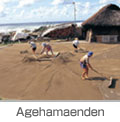
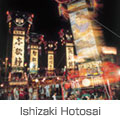
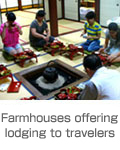
Satoyama and Satoumi are all rooted and integral parts of Noto. Their collective capabilities were highly valued in the designation as Globally Important Agricultural Systems (GIAHS). Noto's agriculture, forestry and fishery industries as well as related human livelihoods were all taken account in the GIAHS designation. One more factor that led to this designation was the increasing interest in Satoyama in recent years by the international community. An example of this is the adoption of "Satoyama Initiative" proposed at the Tenth Meeting of the Conference of the Parties (COP10) to the Convention on Biological Diversity (CBD) held in October 2010 in Nagoya, Aichi Prefecture. What is the Satoyama Initiative? In order to protect both biodiversity and people's livelihood, it is important to preserve not only pristine environments, but also human influenced environments, such as Satoyama's farmlands, secondary forests, and livelihoods, that people have developed and maintained sustainably over a long period of time. The "Satoyama Initiative" was initiated by the Government of Japan to tackle the dual critical issues of maintaining a balance between preservation of biodiversity in pristine environments and their sustainable use. Ishikawa Prefecture, in cooperation with the United Nations University Institute of Advanced Studies jointly founded the "International Partnership for the Satoyama Initiative (IPSI)" |
 |
     Loading
|



















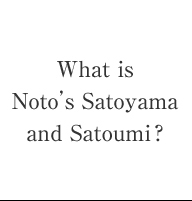







In June 2011, "Noto's Satoyama and Satoumi" which expands across Noto peninsula, along with "Sado's satoyama in Harmony with the Crested Ibis" of Sado City in Nigata, was designated as GIAHS (Globally Important Agricultural Heritage Systems) by the Food and Agriculture Organization of the United Nations (FAO), the first from Japan.
Noto's Satoyama and Satoumi Pamphlet No.1 (PDF 0.8MB)
Noto's Satoyama and Satoumi Pamphlet No.2 (PDF 2.3MB)